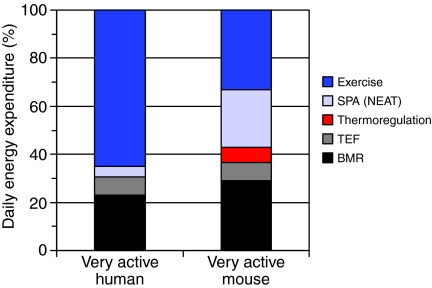Fig. 3.
(A,B) Partitioning of daily energy expenditure (DEE) when the amount of voluntary exercise is extraordinarily high. For humans, this occurs during the Tour de France cycling race (Saris et al., 1989) and for mice it represents the High Runner lines housed with wheel access (Swallow et al., 2001; Vaanholt et al., 2007a; Vaanholt et al., 2007b; Rezende et al., 2009). For the mice, some of the heat produced during wheel running is used for thermoregulation, thus reducing costs of thermoregulation per se. SPA is still a substantial part of the energy budget for mice (Rezende et al., 2009). SPA may also appreciable for these human ultra-racers, but it has not been directly measured to our knowledge. In general, larger-bodied mammals are predicted to expend a larger fraction of their DEE on costs of locomotion, based on previous allometric analyses (Garland, 1983; Goszczynski, 1986). For additional literature sources, see Fig. 2 legend.

